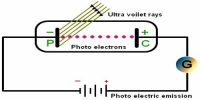Ideas about Conductor, Insulator, and Semiconductor
Substances which we come across are mainly of three types, viz. solid, liquid and gases. According to the variation of electrical conductivities solids are classified into three categories. Substances through which electricity can pass easily are called conductors. Metals like copper, silver, gold, aluminum etc. are conductors of electricity.
Substances through which electricity cannot pass easily are called insulators. Quartz, mica, rubber, ceramics, glass, ebonite etc are the examples of insulators.
There are, however, a large number of solids that are neither good conductor of electricity nor good insulators, their conductivity lies between those of good conductors and insulators. These substances are called semiconductors. Silicon, germanium, cadmium, gallium arsenide etc. are examples of semiconductors.
From the values of specific resistance or conductivity, we can get an idea of how far strong the substance is as a conductor or as an insulator. For example, at a normal temperature specific resistance of copper is 10-8 Ω-m; on the other hand, a specific resistance of glass is 1016 Ω-m. The specific resistance of a semiconductor is between 10-5 Ω-m to 108 Ω-m.
The branch of physics which deals with semiconductor and transistor is called solid-state physics. Germanium and silicon are extensively used as semiconductors. Solid state devices are mainly fabricated from silicon and germanium. It has been said above that the conductivity of semiconductors lies between that of conductors and insulators. At low-temperature semiconductor behaves like an insulator; but if a semiconducting crystal is heated, then it loses its resistance rapidly i.e., its conductivity increases. For a good conductor, the opposite phenomenon happens. That means a resistance of a conductor increases with increasing temperature.
Another special characteristic of a semiconductor are that a tiny fraction (about 1 part in 106) of a particular impurity is mixed with a pure semiconductor, its resistance decreases manifold. This type of mixing is called doping and the semiconductors thus formed are called doped or impure semiconductors. In fabricating different electronic devices and components doped or impure semiconductors are normally used.












